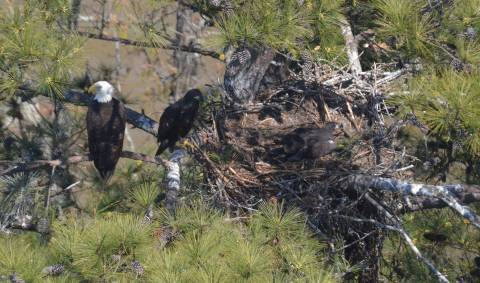 Annual surveys chart most nests and young in decades
Bald eagle populations have hit new highs in Georgia.
Preliminary results from DNR Nongame Conservation Section aerial surveys in January and March documented 188 occupied nesting territories, 148 successful nests and 235 young fledged.
Those are the largest totals recorded for each category in decades. Some 40 years ago, this iconic raptor -- symbol of the U.S. -- had been nearly extirpated across much of its historic range.
Bald eagle nests numbered in the single digits in Georgia when survey leader Jim Ozier started searching for them almost three decades ago.
While nesting has steadily increased since, “We hit the grand slam this year,” said Ozier, a Nongame program manager.
2014 totals easily passed last year’s 171 nesting territories, 130 successful nests and 195 eaglets fledged.
Nests found in new areas this year included at Sweetwater Creek State Park in Lithia Springs, McIntosh Reserve in Carroll County and Rocky Mountain Public Fishing Area near Berry College.
“They continue to select, and do well in, sites that I wouldn’t have considered suitable just a few years ago,” Ozier said.
Survey snapshot
- Occupied nesting territories: 188 (preliminary)
- Successful nests: 148
- Young fledged: 235
- Counties with active nests: 60 (57 in 2013)
- Lead counties: Chatham – 26; Decatur – 14; McIntosh – 12; Camden – 10; Glynn – 10; Liberty – 10
 Show your support
The rebound of bald eagles is powered in part by Georgians who support the state’s Nongame Wildlife Conservation Fund through buying or renewing a wildlife license plate – including the eagle designs. A share of funding from purchases and annual renewals benefits bald eagles and more than 1,000 other Georgia plant and animal species listed as species of conservation concern.
And don't forget: A law change approved this year will roll back the price of all DNR wildlife plates – including the bobwhite and trout tags – to $25. Also, more than 75 percent of all purchase and renewal fees will be devoted to the wildlife programs that depend on them.
All eyes on Berry cam
Berry College, of course, has Georgia’s best-known eagle nest, thanks to the college live-streaming nesting eagles at www.berry.edu/eaglecam. The camera, also shared at www.georgiawildlife.com/berryeaglecam, topped 15 million views this nesting season. Watch B-3's first flight!
|
 Atlanta falcon's first flight
The peregrine falcon eyas, or chick, followed by DNR's nest cam at Atlanta's SunTrust Plaza left one balcony for a lower one May 21 (right). This first flight -- possibly from the fledgling slipping off the balcony railing! -- marks the steady maturing of the falcon first spotted April 16.
While the fledgling can no longer be tracked by the camera at the nest site, it -- likely a she -- will be watched by falcon fans at SunTrust Plaza, including at the international law firm McKenna Long & Aldridge, a cam partner with TERN and The Garden Club of Georgia.
|
Raptors and rangers
DNR Ranger First-Class Tim Hutto investigated the death of a bald eagle in Irwin County last month. X-rays revealed the eagle had not been shot, but possibly died after being injured by another raptor.
Rangers Jordan Crawford and Kate Hargrove helped capture a hurt barred owl in Chatham County and an injured osprey in Long County. Both birds were taken to raptor centers for rehabilitation.
Back to top.
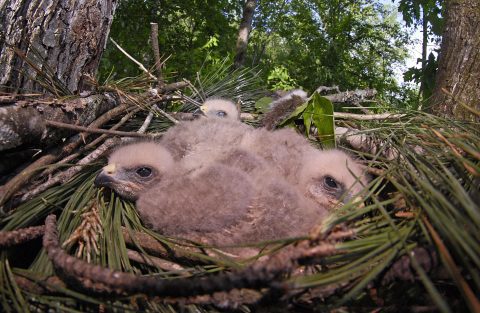
Storms topple nest tree, but biologists re-unite hawk family
By Pete Pattavina
Severe storms that tore through the state in late April had Georgians scrambling to clean up broken limbs, patch roofs and reconnect power lines in the aftermath.
But it wasn’t only humans who were reeling. In Athens, fierce winds overturned a huge white oak with a red-shouldered hawk nest high in its limbs, separating the parent birds from their nestlings.
Working to replace a power pole snapped by the fallen tree, a Georgia Power crew found three, week-old hawk nestlings – called eyasses – huddled on the pavement. The workers quickly contacted DNR raptor expert Jim Ozier for advice, while the two adult birds screeched overhead.
Ozier called Steve Holzman, an Athens-based U.S. Fish and Wildlife Service biologist and president of the Georgia Ornithological Society. Holzman and Clark Jones, president of Oconee Rivers Audubon Society, rushed to the site to retrieve the nestlings before nightfall.
The birds were unharmed but hungry, having been separated from their parents for hours. Holzman fed them chunks of raw chicken and, that night, built a wooden nest platform to place near the fallen tree – with the hope of returning the nestlings to their parents early the next day.
“Hawks have a strong urge to respond to the begging calls of their young,” said Ozier, a program manager with DNR’s Nongame Conservation Section. “If you can get the parent birds to find the new nest quickly enough, the parents will not often abandon their young.”
 In the morning, Holzman and fellow Fish and Wildlife Service biologist Pete Pattavina found a suitable place for the platform, a tree sheltered from direct sun and in sight of the old nest site. Homeowners Mandy and William Dopson were thrilled to have the nest platform on their property and helped the biologists install it and build a new nest for the young hawks.
With tree removal work still going on nearby, the adult hawks seemed reluctant to return. Holzman and Pattavina came back late that afternoon with a small set of speakers and a YouTube video of nestling red-shoulder hawks begging for food, hoping to draw the adults.
But when Holzman climbed the ladder to check on the nestlings, he saw that the parents had left a dead squirrel in the corner of the nest for the young. Then an adult hawk swooped within 50 feet of his head!
The biologists quickly left the new nest and the nestlings alone, satisfied that the young would be best cared for by their parents.
Update: Photos of the growing hawks, taken by Holzman’s wife, Rachel.
This story confirms the importance of leaving “orphaned” wildlife in their natural environment, if possible.
Before any animal is removed from the wild, it must be determined there is not a parent nearby that can still care for the young animal. (For more: "Orphaned wildlife in Georgia.") Contrary to popular belief, young birds will not often be abandoned by the mother bird if a person touches them. Most birds do not have a highly-developed sense of smell, but they do have an iron-clad loyalty to their nestlings, so returning the young to their nest is the first course of action.
Pete Pattavina is a wildlife biologist with the U.S. Fish and Wildlife Service in Athens.
Back to top.
 Organizations across South step up to conserve rare wildflower
With teamwork considered crucial to conserving plants, Georgia aster has a Super Bowl-strength squad on its side.
A powerful lineup of partners including the U.S. Fish and Wildlife Service and Georgia DNR announced an agreement May 16 that will hopefully make this Southern plant more common and keep it off the Endangered Species Act list.
The candidate conservation agreement is part of a larger effort to conserve at-risk plants and animals throughout the Southeast, said Cindy Dohner, Fish and Wildlife Service southeastern regional director.
“Across the South, we’ve really put an emphasis on bringing partners together to recover plants, fish and wildlife before they need protection under the Endangered Species Act. It’s a strategy that’s making great strides, in part because conserving one at-risk plant or animal often benefits others.”
DNR Wildlife Resources Division Director Dan Forster said the state agency has been documenting Georgia aster populations since the mid-2000s, and has revised land management practices, such as increasing the use of prescribed fire, to restore habitats.
Forster also credited the Georgia Plant Conservation Alliance. The public-private network committed to preserving the state’s endangered flora has managed Georgia aster habitats, safeguarded the species and nurtured outplanting projects.
“DNR’s work documenting Georgia aster populations, restoring habitats and partnering with the Georgia Plant Conservation Alliance to expand efforts will dovetail with this critical agreement, which provides the team needed to conserve the species and its habitat,” Forster said.
Combined with other conservation actions, measures outlined in the Georgia aster agreement should prevent the need to federally list the species.
Georgia aster
Symphyotrichum georgianum is a purple flowering plant found in the upper Piedmont and lower mountain regions of Alabama, Georgia and the Carolinas. In 1999, the Fish and Wildlife Service made Georgia aster a candidate for federal listing, meaning it warranted listing but other species were a higher priority.
Agreement partners
Signatories include the Fish and Wildlife Service, Clemson University, DNR, Georgia Department of Transportation, Georgia Power, Mecklenburg County (N.C.) Park and Recreation, National Park Service, North Carolina Department of Agriculture and Consumer Services, and the U.S. Forest Service. Cooperators, who are assisting in conserving Georgia aster largely though research and monitoring, are the natural heritage programs of Alabama, Georgia, North Carolina and South Carolina, Atlanta Botanical Garden, North Carolina Botanical Garden, State Botanical Garden of Georgia, The Citadel, The Nature Conservancy and the U.S. Army Corps of Engineers.
Back to top.
Out my backdoor
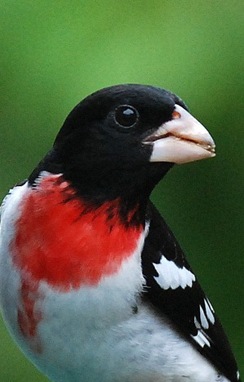 By Terry W. Johnson
You have probably heard that heavy "thump" coming from outside your house, the sickening sound that can mean only one thing – a bird has flown into a window.
A few weeks ago, as soon as my wife and I heard this unmistakable sound, I quickly went outside. To my surprise and dismay, I found a beautiful male rose-breasted grosbeak weakly trying to hop away. This spring we had seen only three rose-breasted grosbeaks in our yard.
As I gently picked up the stunned bird, I could not help but lament over the fact that a bird that had survived the perilous journey from its winter home, somewhere from southern Mexico southward to Ecuador and Venezuela, now faced a life-threatening accident in my backyard.
But this bird was lucky. It survived. Studies have shown that only about half of the birds that strike windows do.
Window strikes are common, occurring throughout the year, and wide-ranging, with documented strikes involving some 25 percent of all bird species known to occur in North America.
But there are a few things you can do to answer this “invisible” threat.
Read on to learn more about the problem, including how to warn birds about windows ...
Terry W. Johnson is a former Nongame program manager with the Wildlife Resources Division and executive director of TERN, the Nongame Conservation Section’s friends group. “Out my backdoor” archives.
Back to top.
|
Noteworthy
Editor’s notes: This will be the only Georgia Wild this month. We’ll send the next issue in early June.
Also, for Gmail users: If Georgia Wild shows up under the Promotions tab – where you’re less likely to see it – here’s how to make sure future issues go to your Primary tab.
Sea turtle nesting season is on, and with it hopes for another record summer. Cumberland Island reported Georgia’s first loggerhead nest May 9 and as of May 22 led all barrier islands in the state, accounting for 16 of 37 nests. Updates.
Coastal boaters are urged to watch for sea turtles and manatees. Boat strikes or injuries consistent with such collisions caused about 25 percent of sea turtle strandings last year (updates) and 31 percent of manatee deaths in Georgia since 2000. Boaters who hit one of these protected animals are urged to stand-by and immediately call 800-2-SAVE-ME (800-272-8363).
When on the beach, remember that protected birds such as American oystercatchers, Wilson’s plovers and least terns nest on the beach in late spring and early summer. What to do? Avoid posted sites, walk below the high-tide line, observe beach birds only from a distance and back away from any nesting birds accidentally disturbed. For more: Share the beach.
Young birders set event records for bird species seen or heard during DNR’s annual Youth Birding Competition April 25-26. Eight of the 24 teams listed more than 100 species, and two topped the record – Flutter Brothers, the overall winner, with 162 species, and Chaotic Kestrels with 156.
’Seen the statewide winning art in the 24th annual Give Wildlife a Chance Poster Contest? Selected from almost 2,500 K-fifth-graders from 21 schools and homeschool groups, the work of these 12 elementary students captured the essence of the contest and the judges’ eyes.
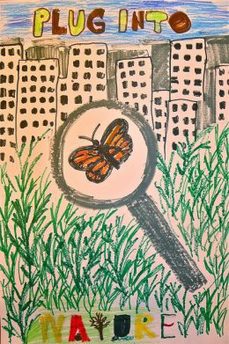 Jess Willadsen’s poster – depicting a butterfly under a magnifying glass with buildings in the background (left) – is one of those statewide winners. Yet on April 12, the 10-year-old girl from Avondale Estates died in a house fire that also killed her mother, Tami Willadsen. Her brother Jack was severely burned and her father, Dave Willadsen, suffered minor burns. Tami was director of philanthropy for The Nature Conservancy in Georgia. Jess shared that interest in nature.
Contest coordinators Linda May of the Nongame Conservation Section and Cora Keber of the State Botanical Garden of Georgia learned of the connection between the entry and the tragedy after announcing the winners.
“Not seeing any of the students' names at the time, I remember hand-picking Jess's piece from the Division 3 (third- and fourth-grade) batch during the contest judging,” May wrote. “I really loved how she understood that wildlife can be appreciated and enjoyed everywhere, even in urban environments. No doubt, Tami played a large role in teaching her daughter to love nature.”
Family and friends have established a fund for the Willadsens, whose home was destroyed. The Nature Conservancy has also developed the Tami and Jess Willadsen Memorial Conservation Fund to “help protect the Georgia they loved.”
|
The comment period for listing Georgia rockcress, a rare plant found only in Georgia and Alabama and proposed for federal status as threatened, has been re-opened until June 10. Comments will also be taken on designating 793 acres of river bluff as critical habitat, with the U.S. Fish and Wildlife Service making a draft economic analysis of that designation available. In Georgia, proposed critical habitat sites are in Chattahoochee, Clay, Floyd, Gordon, Harris and Muscogee counties.
Nongame biologist Thomas Floyd and wildlife technician Grover Brown have found two new bog turtle populations – one each in north Georgia’s Rabun and Towns counties. That makes 10 known populations in Georgia for the federally threatened turtle, and the first observation in Rabun County since 1980.
Bog turtle survey work with Clemson University researchers documented nine mountain bog wetlands in Georgia that could be suitable for the species. Thomas Floyd and Grover Brown also recorded the first known population of eastern mud turtles in the southern Appalachians.
The alligator snapping turtle is actually three species, not one, according to research published last month in the journal Zootaxa. The paper further reveals that Georgia is home to two of those species, the Suwannee and Apalachicola.
 Prescribed fire is helping conserve a private Coastal Plain pitcherplant bog and adjacent wiregrass longleaf pine uplands in southeast Georgia. A recent burn led by the Nongame Conservation Section, the fifth in eight years, included The Nature Conservancy and Georgia Forestry Commission, and continued a long-term partnership with private landowners to restore this rare habitat.
Another conservation partnership has preserved 2,700 acres of wildlife habitat in southeast Georgia’s Jeff Davis County, opening to the public a place valued for recreational opportunities and rare species. The Flat Tub Wildlife Management Area addition recently announced by DNR and The Conservation Fund joins nearly 18,000 acres conserved along this Ocmulgee River stretch. Georgia Outdoor Map app.
JAKES day drew nearly 750 visitors to Charlie Elliott Wildlife Center, near Mansfield. Co-sponsored by the Georgia chapter of the National Wild Turkey Federation, the event included a free kids’ fishing event, archery, live animal presentations, tree climbing opportunities and more.
Got nuisance wildlife? The Wildlife Resources Division has a web page dedicated to helping you. There’s even a new video about how to cope with wildlife issues.
Names in the news: Nongame Conservation Section Chief Mike Harris will become at-risk species coordinator for the U.S. Fish and Wildlife Service’s Southeast Region on June 1. Harris has led nongame conservation for DNR’s Wildlife Resources Division since the agency upgraded the nongame program to a section 16 years ago. Annual report video featuring Harris. The International Sea Turtle Society has honored biologist Anne Meylan of the Florida Fish and Wildlife Conservation Commission’s Fish and Wildlife Research Institute with a Lifetime Achievement Award. Meylan's research includes the 1999 the paper that justified the critically endangered status of hawksbill turtles for the International Union for Conservation of Nature.
Upcoming:
Back to top.
Headlines
"Tag fees give Georgia's wildlife a better chance," Quail Forever (Facebook). Also: Unicoi Outfitters
"Georgia records first sea turtle nest of season," Savannah Morning News. Also: The Florida Times-Union and others via AP
"Guarding the nest" (Georgia sea turtles, featuring DNR's Mark Dodd), Atlanta Magazine
"Agreement to protect flower across Southeast," Fox5 Atlanta (WAGA-TV). Also: Atlanta Business Chronicle, The (Gainesville) Times, AccessNorthGa.com, Scientific American, The Chattanoogan.com and others via AP
"Officials: Give beach-nesting birds their space," WSAF-TV (Montgomery, Ala.)
"Peregrine falcons thrive atop Atlanta skyscraper," mySA (San Antonio, Texas) and others via AP
"Camera offers unique look at peregrine falcons," WGLC-TV (CBS46, Atlanta). Also: Cartersville Patch
"Boaters urged to slow down, watch for sea turtles and manatees," WSAV-TV (Savannah) and others via AP
"Flat Tub WMA addition rich in wildlife, habitat and recreation in southeast Georgia," The Conservation Fund. Also: The Outdoor Wire
"Guilty: Crabs are killing N.E. saltmarshes," Brown University
"Indigo season wrap," The Orianne Society blog
"Wild animals visit Brookdale Elementary homework center" (featuring DNR's Pete Griffin), The Macon Telegraph
"Declines in large wildlife lead to increases in disease risk," University of California Santa Barbara
"Crocodile tears please thirsty butterflies and bees," Ecological Society of America
"Road crews working around barn swallow in South Hall project," The (Gainesville) Times
"Frustrated fish get feisty," Science News
"Georgia and its residents will benefit by investing in trails statewide," Saporta Report
Parting shot
Video and photos
"Falcons tagged for tracking at Atlanta high-rise," Associated Press
"Partners sign agreement to preserve rare plant (slideshow)," Atlanta Business Chronicle
"NOAA entanglement team cuts rope off humpback whale (in Monterey Bay)," KSBW-TV (Monterey, Calif.)
"Mysterious deepwater fish (lancetfish) found along N.C. coast," WNCN-TV (Raleigh, N.C.)
"Shrimper who caught rare goblin shark: 'Man, he's ugly!'" CNN
Back to top.
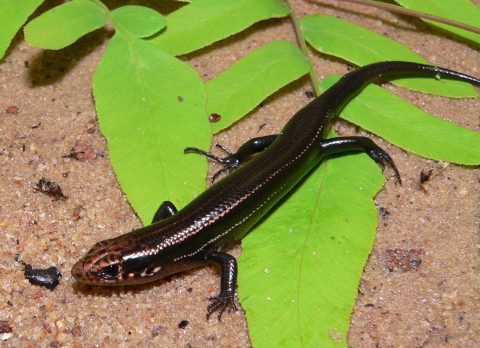 You’re looking at the first southern coal skink documented in Georgia since 1975. Ben
Morrison, of the Nongame Conservation Section’s seasonal fire crew, caught this one while
working in a bog at Black Creek Natural Area in Taylor County. Senior wildlife biologist
Nathan Klaus first reported seeing the uncommon skinks in the bog several years ago.
Fellow biologists began a trapping effort this year. Then, while working with fire crew
members in late April at Black Creek, Klaus writes that he “charged them to catch any
lizard they saw.” “Madeline Engstrom saw the skink and Ben Morrison was the lucky first
one to lay his hands on it.” The previous southern coal skink on record was found farther
south, in Sumter County.
Credits
** Masthead: Georgia aster in bloom. Michele Elmore/The Nature Conservancy of Georgia
** Eagle nest with two young. Jim Ozier/Ga. DNR
** Atlanta peregrine fledgling. Laura Miller/McKenna Long & Aldridge
** Red-shouldered hawk eyasses in a nest platform await the return of their parents. Pete Pattavina/USFWS
** Homeowner William Dopson hands Fish and Wildlife Service biologist Steve Holzman a red-shouldered hawk chick to place in the nest platform. Pete Pattavina/USFWS
** Celebrating the Georgia aster agreement at Atlanta Botanical Garden: from left, Georgia Department of Transportation Commissioner Keith Golden, National Park Service Deputy Regional Director Sherri Fields, U.S. Fish and Wildlife Service Southeast Regional Director Cindy Dohner, DNR Wildlife Resources Division Director Dan Forster, U.S. Forest Service Regional Forester Liz Agpaoa, Georgia Power Vice President of Environmental Affairs Ron Shipman, Atlanta Botanical Garden Vice President for Science and Conservation Dr. Jennifer Cruse-Sanders, State Botanical Garden of Georgia Conservation Coordinator Jennifer Ceska. Cedric Mohr/Ga. DOT
** Male rose-breasted grosbeak. Terry W. Johnson
** Jess Willadsen's entry in the Give Wildlife a Chance Poster Contest.
** Nongame employee Rebecca Pudner, who is researching pitcherplants, poses with the rare plants during a prescribed fire at a private Coastal Plain bog in southeast Georgia. provided by Shan Cammack/Ga. DNR
** Coal skink. John Jensen/Ga. DNR
Back to top.
 Give wildlife a chance!
The Nongame Conservation Section of Georgia
DNR receives no state funds to
conserve nongame wildlife, native plants and natural habitats. Instead, we depend on contributions, grants and fundraisers, such as the eagle and hummingbird license plates.
How can you help?
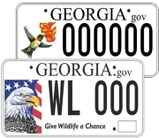
|